The Role of Hybrid Battery–SMES Energy Storage in Enriching the Permanence of PV–Wind DC Microgrids: A Case Study
Abstract
:1. Introduction
- Introducing a comparative study between utilizing the battery only and using a hybrid battery-SMES system to unify their merits in enriching the DC microgrid overall performance. This approach is seldomly addressed in the literature.
- Mitigating the distinct instabilities of DC bus voltage and leveling the load power demand using the proposed control approach. The proposed control schemes for both battery and SMES offer simple implementation and high efficiency against the weather changes and RES insertion/outage.
- Keeping the load voltage/frequency steady using the proposed load controller is accomplished using the system inverter during weather changes and RES insertion/outage instants.
2. System and Methods
2.1. The Wind System
2.2. The PV System
2.3. Battery Energy Storage System (BSS)
2.4. Superconducting Magnetic Energy Storage System (SMES)
3. Control Approaches
3.1. Control of the Wind System
3.2. Control of the PV System
3.3. The Battery Control System
3.4. The SMES Control System
3.5. The Inverter Control System
4. Results and Discussion
5. Conclusions
Author Contributions
Funding
Institutional Review Board Statement
Informed Consent Statement
Data Availability Statement
Acknowledgments
Conflicts of Interest
References
- Abdalla, A.N.; Nazir, M.S.; Tao, H.; Cao, S.; Ji, R.; Jiang, M.; Yao, L. Integration of energy storage system and renewable energy sources based on artificial intelligence: An overview. J. Energy Storage 2021, 40, 102811. [Google Scholar] [CrossRef]
- Al-Ismail, F.S. DC Microgrid Planning, Operation, and Control: A Comprehensive Review. IEEE Access 2021, 9, 36154–36172. [Google Scholar] [CrossRef]
- Chen, X.; Xiao, J.; Yuan, J.; Xiao, Z.; Gang, W. Application and performance analysis of 100% renewable energy systems serving low-density communities. Renew. Energy 2021, 176, 433–446. [Google Scholar] [CrossRef]
- Elmorshedy, M.F.; Elkadeem, M.R.; Kotb, K.M.; Taha, I.B.; Mazzeo, D. Optimal design and energy management of an isolated fully renewable energy system integrating batteries and supercapacitors. Energy Convers. Manag. 2021, 245, 114584. [Google Scholar] [CrossRef]
- IEA. Global Energy Review 2021. Available online: https://www.iea.org/reports/global-energy-review-2021 (accessed on 25 October 2021).
- Salama, H.S.; Vokony, I. Voltage and Frequency Control of Balanced/Unbalanced Distribution System Using the SMES System in the Presence of Wind Energy. Electricity 2021, 2, 205–224. [Google Scholar] [CrossRef]
- Salama, H.S.; Aly, M.M.; Abdel-Akher, M.; Vokony, I. Frequency and voltage control of Microgrid with high WECS penetration during wind gusts using superconducting magnetic energy storage. Electr. Eng. 2019, 1013, 771–786. [Google Scholar] [CrossRef]
- Koohi-Fayegh, S.; Rosen, M.A. A review of energy storage types, applications and recent developments. J. Energy Storage 2020, 27, 101047. [Google Scholar] [CrossRef]
- Salama, H.S.; Vokony, I. Comparison of different electric vehicle integration approaches in presence of photovoltaic and superconducting magnetic energy storage systems. J. Clean. Prod. 2020, 260, 121099. [Google Scholar] [CrossRef]
- Salama, H.S.; Vokony, I. Application of controlled SMES with Integrating PV System and Electric Vehicles into Power System. In Proceedings of the 2019 7th International Youth Conference on Energy (IYCE), Bled, Slovenia, 3–6 July 2019. [Google Scholar] [CrossRef]
- Elmorshedy, M.F.; Kotb, K.M.; Dan, A. Hybrid Renewable Microgrid System Based DC-bus Scheme for Residential Load Applications. In Proceedings of the 2019 22nd International Conference on Electrical Machines and Systems (ICEMS), Harbin, China, 11–14 August 2019. [Google Scholar] [CrossRef]
- Juma, M.I.; Mwinyiwiwa, B.M.M.; Msigwa, C.J.; Mushi, A.T. Design of a Hybrid Energy System with Energy Storage for Standalone DC Microgrid Application. Energies 2021, 14, 5994. [Google Scholar] [CrossRef]
- Sitompul, S.; Fujita, G. Impact of Advanced Load-Frequency Control on Optimal Size of Battery Energy Storage in Islanded Microgrid System. Energies 2021, 14, 2213. [Google Scholar] [CrossRef]
- Sitompul, S.; Hanawa, Y.; Bupphaves, V.; Fujita, G. State of Charge Control Integrated with Load Frequency Control for BESS in Islanded Microgrid. Energies 2020, 13, 4657. [Google Scholar] [CrossRef]
- Alam, M.S.; Al-Ismail, F.S.; Abido, M.A. PV/Wind-Integrated Low-Inertia System Frequency Control: PSO-Optimized Fractional-Order PI-Based SMES Approach. Sustainability 2021, 13, 7622. [Google Scholar] [CrossRef]
- Alattar, A.H.; Selem, S.I.; Metwally, H.; Ibrahim, A.; Aboelsaud, R.; Tolba, M.A.; El-Rifaie, A.M. Performance enhancement of micro grid system with SMES storage system based on mine blast optimization algorithm. Energies 2019, 12, 3110. [Google Scholar] [CrossRef] [Green Version]
- Gu, W.; Liu, W.; Wu, Z.; Zhao, B.; Chen, W. Cooperative control to enhance the frequency stability of islanded microgrids with DFIG-SMES. Energies 2013, 6, 3951–3971. [Google Scholar] [CrossRef]
- Magdy, G.; Bakeer, A.; Nour, M.; Petlenkov, E. A New Virtual Synchronous Generator Design Based on the SMES System for Frequency Stability of Low-Inertia Power Grids. Energies 2020, 13, 5641. [Google Scholar] [CrossRef]
- Chen, L.; Chen, H.; Li, Y.; Li, G.; Yang, J.; Liu, X.; Xu, Y.; Ren, L.; Tang, Y. SMES-Battery Energy Storage System for the Stabilization of a Photovoltaic-Based Microgrid. IEEE Trans. Appl. Supercond. 2018, 28, 1–7. [Google Scholar] [CrossRef]
- Salama, H.S.; Said, S.M.; Aly, M.; Vokony, I.; Hartmann, B. Studying impacts of electric vehicle functionalities in wind energy-powered utility grids with energy storage device. IEEE Access 2021, 9, 45754–45769. [Google Scholar] [CrossRef]
- Omran, K.C.; Mosallanejad, A. SMES/battery hybrid energy storage system based on bidirectional Z-source inverter for electric vehicles. IET Electr. Syst. Transp. 2018, 8, 215–220. [Google Scholar] [CrossRef]
- Bakeer, A.; Salama, H.S.; Vokony, I. Integration of PV system with SMES based on model predictive control for utility grid reliability improvement. Prot. Control Mod. Power Syst. 2021, 6, 1–13. [Google Scholar] [CrossRef]
- Yang, B.; Zhu, T.; Zhang, X.; Wang, J.; Shu, H.; Li, S.; He, T.; Yang, L.; Yu, T. Design and implementation of Battery/SMES hybrid energy storage systems used in electric vehicles: A nonlinear robust fractional-order control approach. Energy 2020, 191, 116510. [Google Scholar] [CrossRef]
- Shim, J.W.; Cho, Y.; Kim, S.J.; Min, S.W.; Hur, K. Synergistic control of SMES and battery energy storage for enabling dispatchability of renewable energy sources. IEEE Trans. Appl. Supercond. 2013, 23, 5701205. [Google Scholar] [CrossRef]
- Elmorshedy, M.; Amin, M.M.; El-Sousy, F.F.; Mohammed, O.A. DC-Bus Voltage Control of MPPT-based Wind Generation System Using Hybrid BESS-SMES System for Pulse Loads in Ship Power Applications. In Proceedings of the 2021 IEEE Applied Power Electronics Conference and Exposition (APEC), Phoenix, AZ, USA, 14–17 June 2021; pp. 76–82. [Google Scholar] [CrossRef]
- Jin, J.X.; Wang, J.; Yang, R.H.; Zhang, T.L.; Mu, S.; Fan, Y.J.; Xing, Y.Q. A superconducting magnetic energy storage with dual functions of active filtering and power fluctuation suppression for photovoltaic microgrid. J. Energy Storage 2021, 38, 102508. [Google Scholar] [CrossRef]
- Chen, L.; Zhang, X.; Han, P.; Chen, H.; Xu, Y.; Ren, L.; Tang, Y. Optimization of SMES-Battery Hybrid Energy Storage System for Wind Power Smoothing. In Proceedings of the 2020 IEEE International Conference on Applied Superconductivity and Electromagnetic Devices (ASEMD), Tianjin, China, 16–18 October 2020; pp. 1–2. [Google Scholar] [CrossRef]
- Rajapakse, G.; Jayasinghe, S.; Fleming, A. Power Management of an Oscillating Water Column Wave Energy Converter with Battery/Supercapacitor Hybrid Energy Storage. In Proceedings of the 2018 8th International Conference on Power and Energy Systems (ICPES), Colombo, Sri Lanka, 21–22 December 2018; pp. 246–251. [Google Scholar] [CrossRef]
- Rout, T.; Maharana, M.K.; Chowdhury, A.; Samal, S. A Comparative study of Stand-alone Photo-Voltaic System with Battery storage system and Battery Supercapacitor storage system. In Proceedings of the 2018 4th International Conference on Electrical Energy Systems (ICEES), Chennai, India, 7–9 February 2018; pp. 77–81. [Google Scholar] [CrossRef]
- Wongdet, P.; Marungsri, B. Hybrid Energy Storage System in Standalone DC Microgrid with Ramp Rate Limitation for Extending the Lifespan of Battery. In Proceedings of the 2018 International Electrical Engineering Congress (iEECON), Krabi, Thailand, 7–9 March 2018; pp. 1–4. [Google Scholar] [CrossRef]
- Tremblay, O.; Dessaint, L.A.; Dekkiche, A.I. A generic battery model for the dynamic simulation of hybrid electric vehicles. In Proceedings of the VPPC 2007—2007 IEEE Vehicle Power and Propulsion Conference, Arlington, TX, USA, 9–12 September 2007; pp. 284–289. [Google Scholar] [CrossRef]
- Allam, S.M.; Elmorshedy, M.F.; Rashad, E.M. Load Power and State-of-Charge Management Strategy with MPPT of Wind-Driven Isolated PMSG. In Proceedings of the 22nd International Conference on Electrical Machines (ICEM), Lausanne, Switzerland, 4–7 September 2016; pp. 1098–1104. [Google Scholar]
- Salama, H.S.; Abdel-Akher, M.; Aly, M.M. Development energy management strategy of SMES-based Microgrid for stable islanding transition. In Proceedings of the 2016 Eighteenth International Middle East Power Systems Conference (MEPCON), Cairo, Egypt, 27–29 December 2016; pp. 413–418. [Google Scholar] [CrossRef]
- Salama, H.S.; Vokony, I. Power Stability Enhancement of SCIG and DFIG Based Wind Turbine Using Controlled-SMES. Int. J. Renew. Energy Res. 2019, 9, 147–156. [Google Scholar]
- Yang, Y.; Wei, B.; Chen, P.; Zhang, H.; Qiu, M.; Zhang, D. The quench protection system for superconducting magnetic energy storage. IEEE Trans. Appl. Supercond. 2012, 23, 4700704. [Google Scholar] [CrossRef]
- Faisal, M.; Hannan, M.A.; Ker, P.J.; Hussain, A.; Mansor, M.B.; Blaabjerg, F. Review of energy storage system technologies in microgrid applications: Issues and challenges. IEEE Access 2018, 6, 35143–35164. [Google Scholar] [CrossRef]
- Melhem, Z. (Ed.) High Temperature Superconductors (HTS) for Energy Applications; Elsevier: Amsterdam, The Netherlands, 2011. [Google Scholar]
- Johnson, S.C.; Davidson, F.T.; Rhodes, J.D.; Coleman, J.L.; Bragg-Sitton, S.M.; Dufek, E.J.; Webber, M.E. Selecting favorable energy storage technologies for nuclear power. In Storage and Hybridization of Nuclear Energy; Academic Press: Cambridge, MA, USA, 2019; pp. 119–175. [Google Scholar]
- Kotb, K.M.; Elkadeem, M.R.; Elmorshedy, M.F.; Dán, A. Coordinated power management and optimized techno-enviro-economic design of an autonomous hybrid renewable microgrid: A case study in Egypt. Energy Convers. Manag. 2020, 221, 113185. [Google Scholar] [CrossRef]
- Liu, F.; Duan, S.; Liu, F.; Liu, B.; Kang, Y. A variable step size INC MPPT method for PV systems. IEEE Trans. Ind. Electron. 2008, 55, 2622–2628. [Google Scholar] [CrossRef] [Green Version]
- Kotb, K.M.; Elmorshedy, M.F.; Dán, A. Performance Assessment of Integrating SMES and Battery Storage Systems with Renewable DC-bus Microgrids: A Comparison. Period. Polytech. Electr. Eng. Comput. Sci. 2021, 65, 382–393. [Google Scholar] [CrossRef]
- Kotb, K.M.; Elmorshedy, M.F.; Salama, H.S.; Dán, A. Enriching the stability of solar/wind DC microgrids using battery and superconducting magnetic energy storage based fuzzy logic control. J. Energy Storag. 2022, 45, 103751. [Google Scholar] [CrossRef]
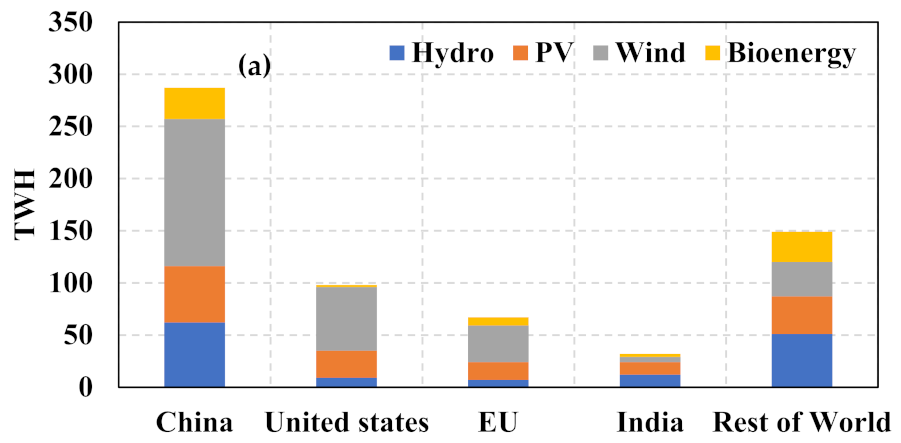
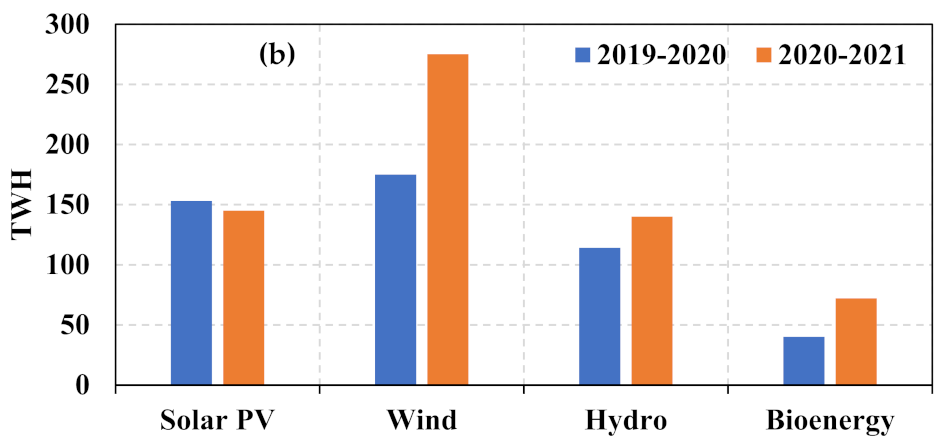
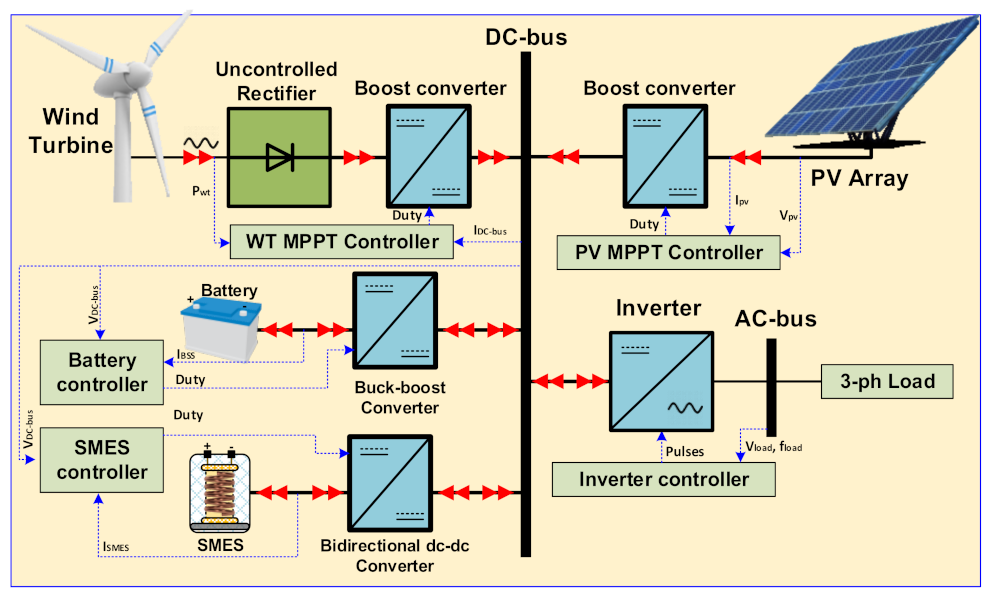
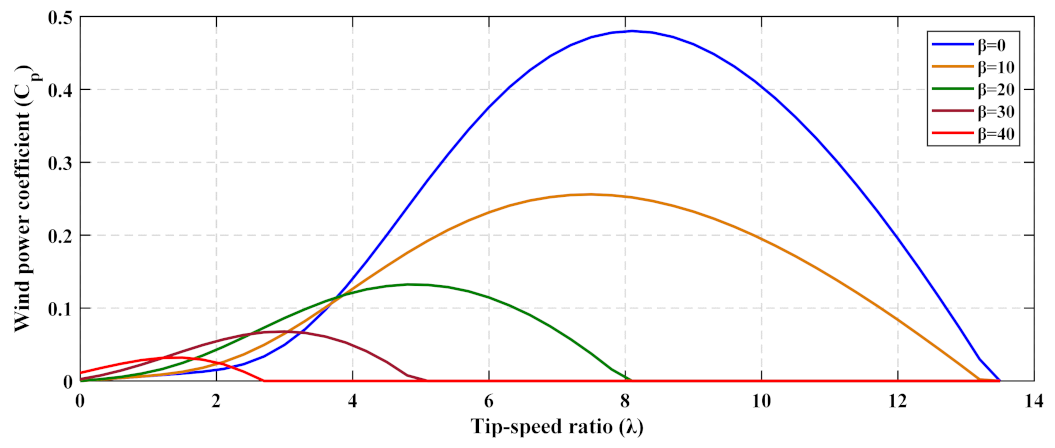

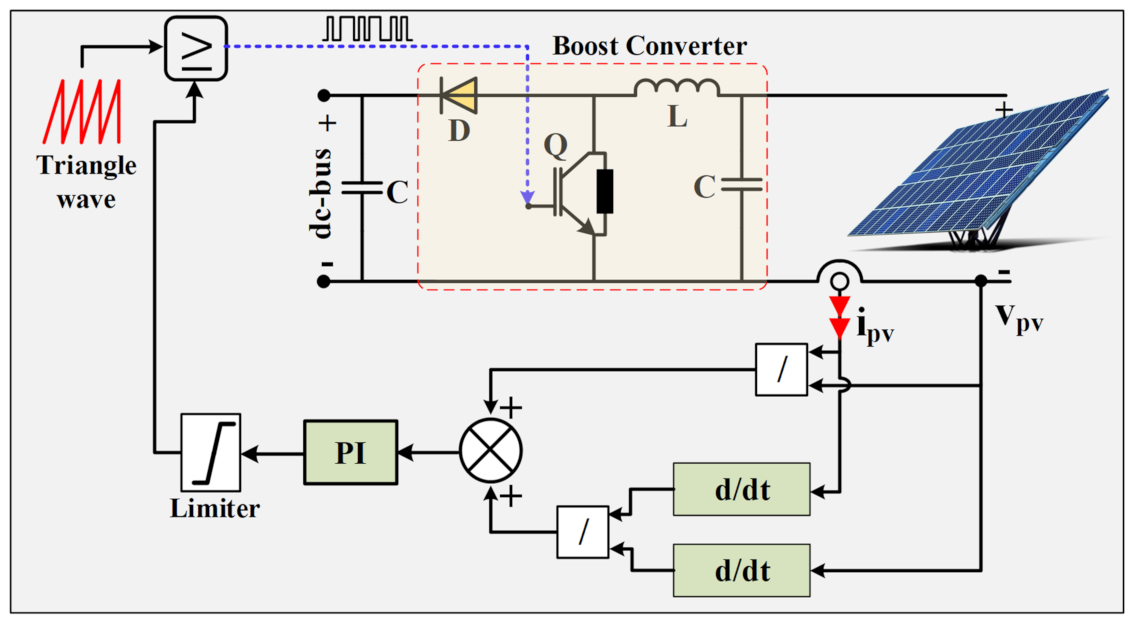
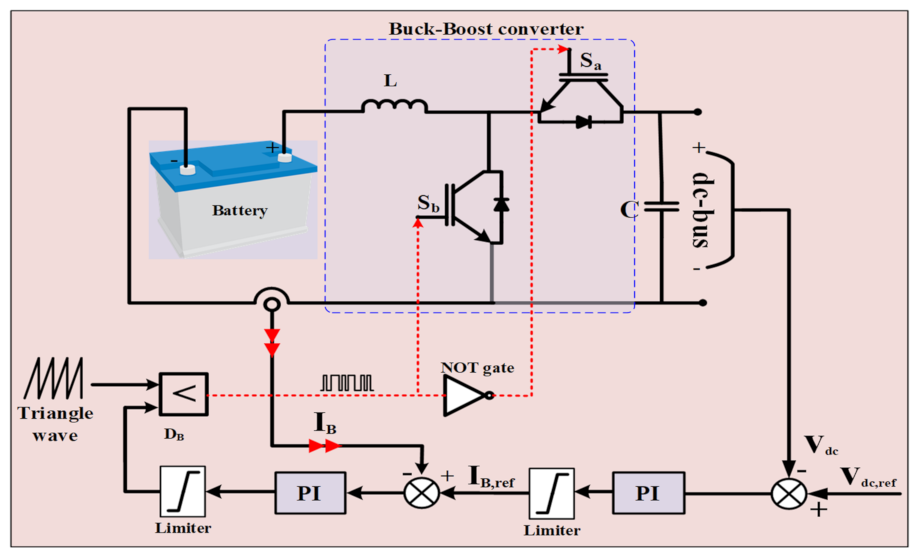
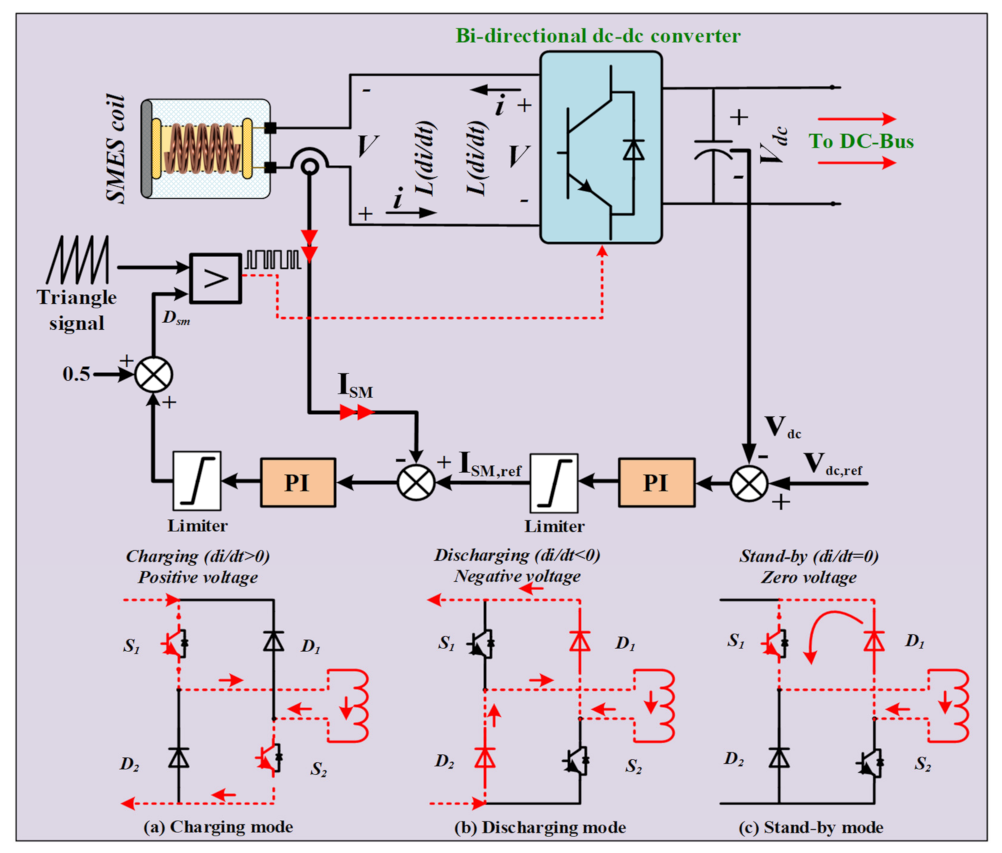

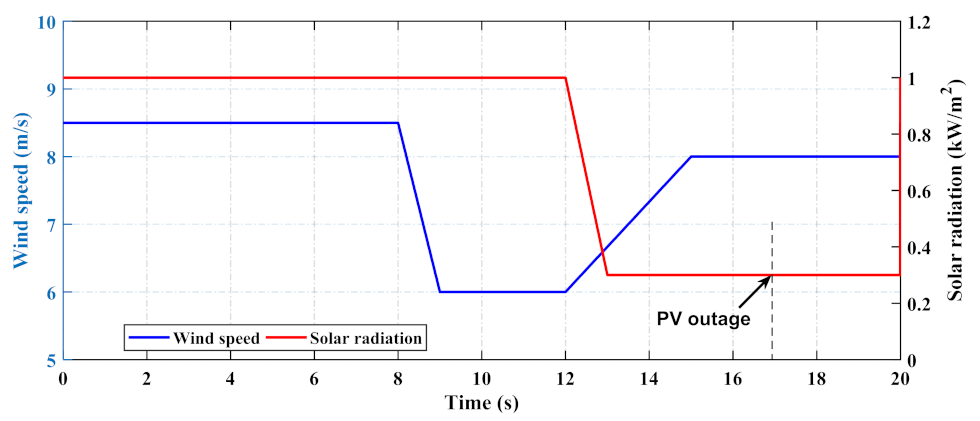
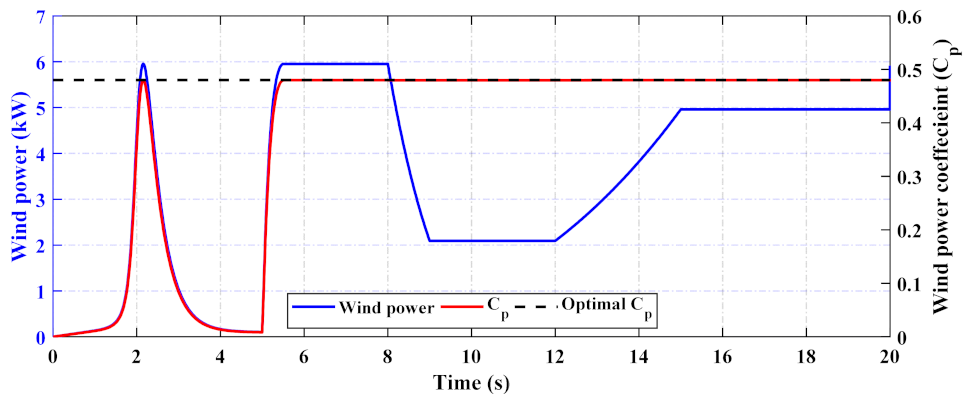
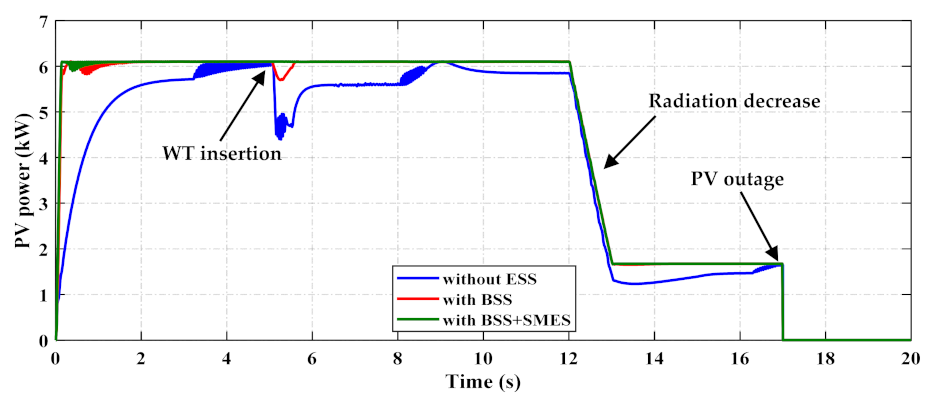

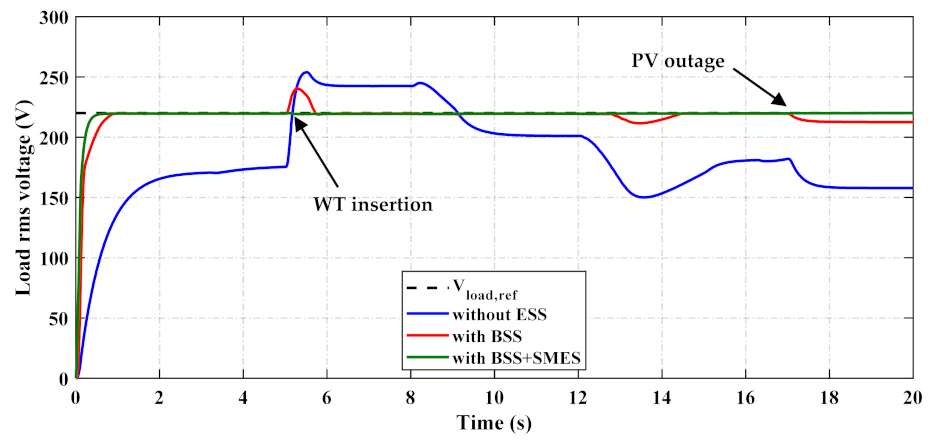
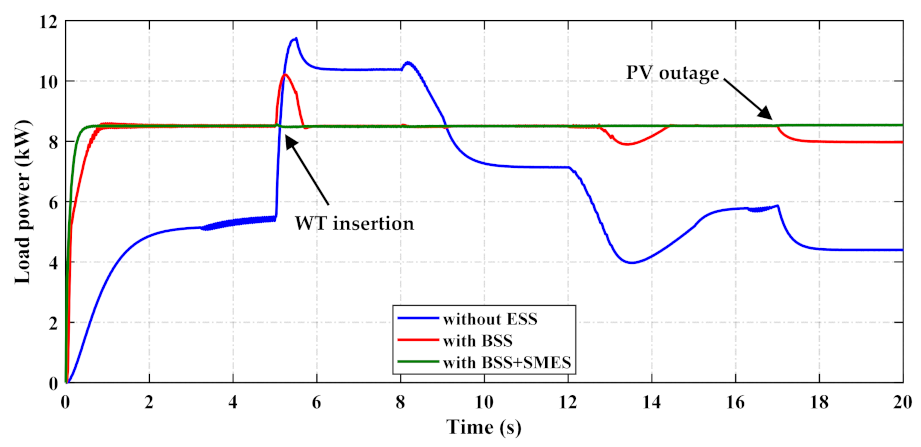
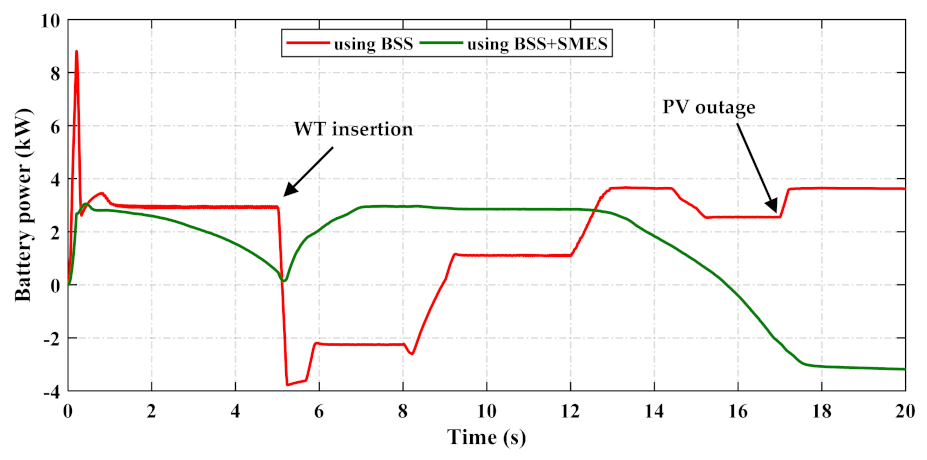
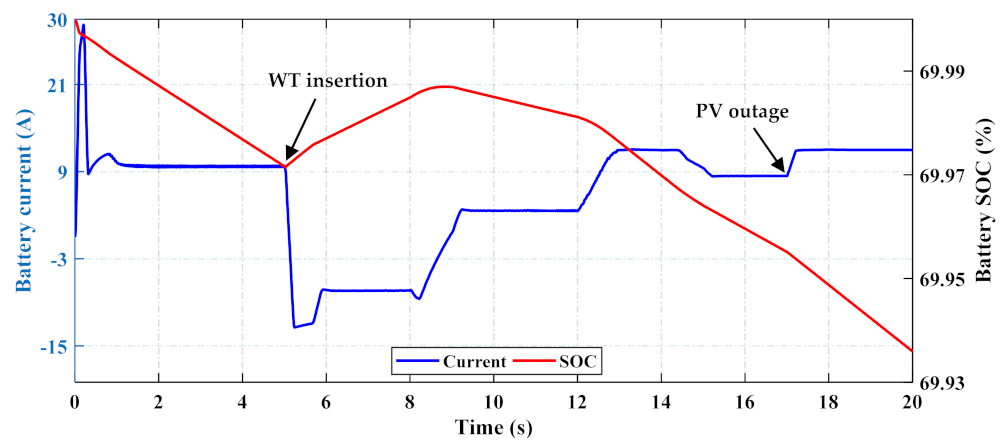
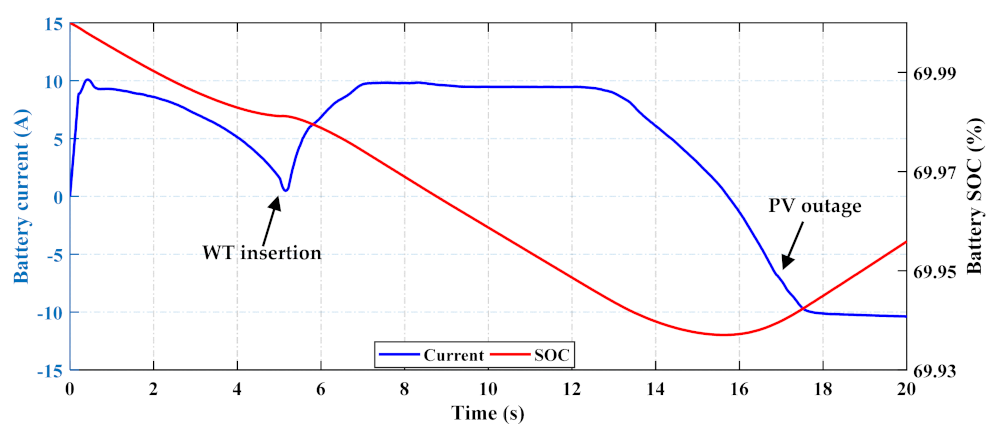
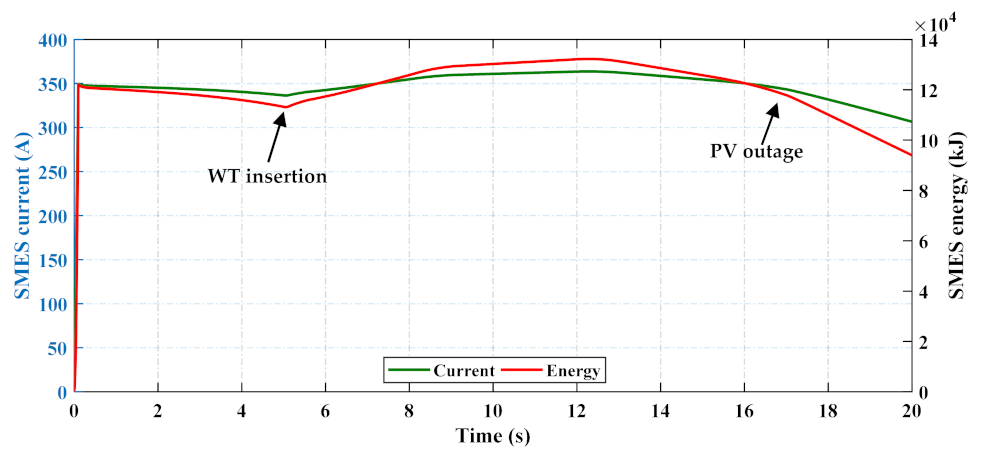
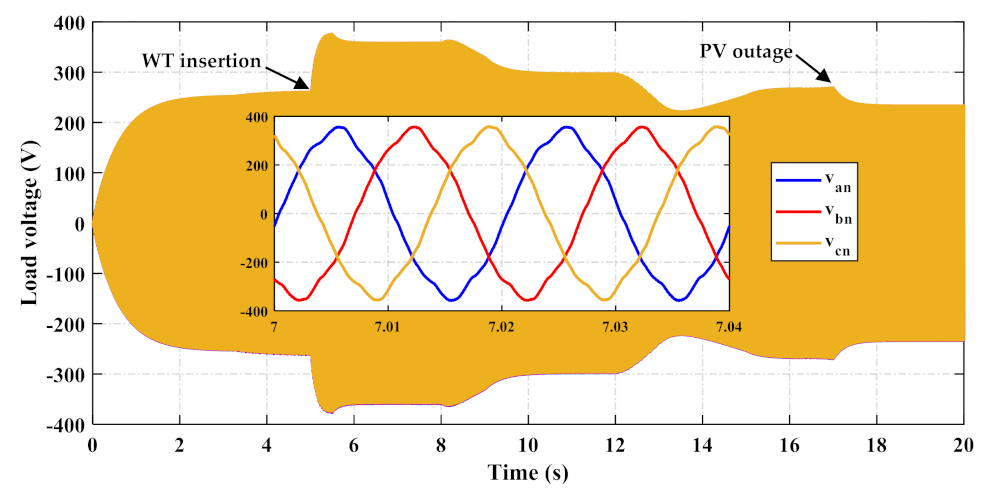


| Ref. | Utilized RESs | BUS Type | Grid- | Utilized Hybrid ESS | ESS Controller | Case Studies | ||
|---|---|---|---|---|---|---|---|---|
| PV | WT | On | Off | |||||
| [25] | - | ✓ | DC | - | ✓ | Battery + SMES | PI | Variable wind speed |
| [26] | ✓ | - | AC | ✓ | - | Battery + SMES | PI + FLC | Load change |
| [27] | - | ✓ | AC | ✓ | - | Battery + SMES | PI | Variable wind speed |
| [28] | - | ✓ | DC | ✓ | - | Battery + Supercapacitor | PI | Variable wind speed |
| [29] | ✓ | - | DC | - | ✓ | Battery + Supercapacitor | Rule-Based Controller (RBC) | Variable solar irradiation and load change |
| [30] | ✓ | ✓ | DC | - | ✓ | Battery + Supercapacitor | Ramp Rate Limitation (RRL) | Load change |
| Current study | ✓ | ✓ | DC | - | ✓ | Battery + SMES | PI | PV outage, WT insertion, variable solar radiation and wind speed |
| The WT | The PMSG | ||
|---|---|---|---|
| Parameter | Value | Parameter | Value |
| Rated power | 7 kW | Rated power | 6.1 kW |
| Blades radius | 3.2 m | Rated torque | 40 N m |
| Cut-in wind speed | 4 m/s | Rated speed | 153 rad/s |
| Cut-out wind speed | 12 m/s | Rated current | 12 A |
| Friction coefficient | 0.06 N m s/rad | Resistance of armature | 0.4 Ω |
| Inertia | 7.5 kg m2 | Inductance of stator | 8.4 mH |
| Parameter | Value |
|---|---|
| Open-circuit voltage | 321 V |
| Short-circuit current | 18.4 A |
| Max. power point voltage Vmp | 273.5 V |
| Max. power point current Imp | 22.32 A |
| Parallel strings | 4 |
| Series modules/string | 5 |
| Parameter | Value |
|---|---|
| Esm | 120 kJ |
| Lsm | 2 H |
| Ism | 350 A |
Publisher’s Note: MDPI stays neutral with regard to jurisdictional claims in published maps and institutional affiliations. |
© 2022 by the authors. Licensee MDPI, Basel, Switzerland. This article is an open access article distributed under the terms and conditions of the Creative Commons Attribution (CC BY) license (https://creativecommons.org/licenses/by/4.0/).
Share and Cite
Salama, H.S.; Kotb, K.M.; Vokony, I.; Dán, A. The Role of Hybrid Battery–SMES Energy Storage in Enriching the Permanence of PV–Wind DC Microgrids: A Case Study. Eng 2022, 3, 207-223. https://doi.org/10.3390/eng3020016
Salama HS, Kotb KM, Vokony I, Dán A. The Role of Hybrid Battery–SMES Energy Storage in Enriching the Permanence of PV–Wind DC Microgrids: A Case Study. Eng. 2022; 3(2):207-223. https://doi.org/10.3390/eng3020016
Chicago/Turabian StyleSalama, Hossam S., Kotb M. Kotb, Istvan Vokony, and András Dán. 2022. "The Role of Hybrid Battery–SMES Energy Storage in Enriching the Permanence of PV–Wind DC Microgrids: A Case Study" Eng 3, no. 2: 207-223. https://doi.org/10.3390/eng3020016
APA StyleSalama, H. S., Kotb, K. M., Vokony, I., & Dán, A. (2022). The Role of Hybrid Battery–SMES Energy Storage in Enriching the Permanence of PV–Wind DC Microgrids: A Case Study. Eng, 3(2), 207-223. https://doi.org/10.3390/eng3020016







